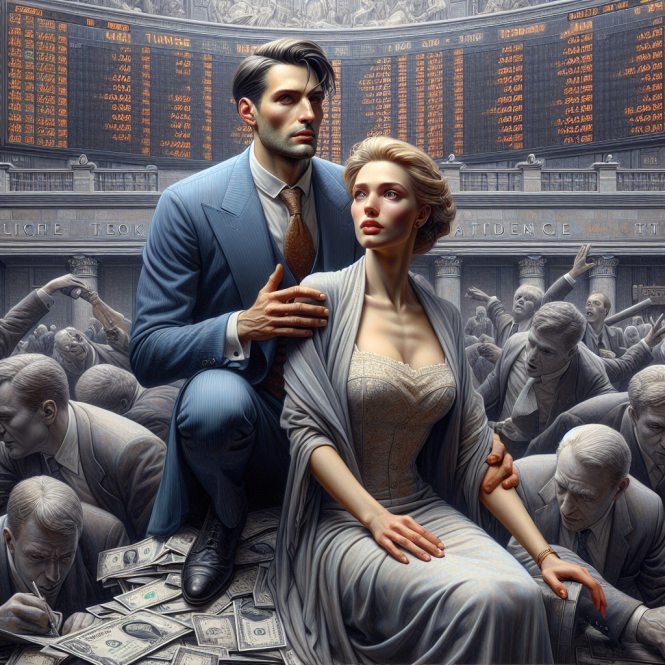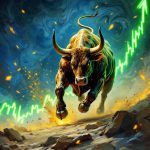2025 Crash? Sleep Tight, Think Right
“Come to the edge,” He said. They said, “We are afraid.” “Come to the edge,” He said. They came. He pushed them… and they flew. —Guillaume Apollinaire
April 10, 2025
Fear has a better publicist than opportunity. Red charts and panicked anchors crank cortisol and sell ad space—but they don’t build wealth. The so-called “Stock Market Collapse of 2025” is not an extinction-level event. It’s a psychological sorting mechanism. A trigger. A test. A transfer. Weak hands exit stage left. Value hunters enter the frame.
Most people think a crash means loss. But loss only comes when you mistake noise for signal. What we’re witnessing isn’t the end of the market. It’s the liquidation of delusion. Bloated narratives are getting priced out. Capital is recalibrating. This is not chaos—it’s reallocation with the volume cranked to max.
And if you’re losing sleep, you’re misaligned with history. Markets don’t punish risk-takers. They punish the unprepared.
The Signal Is Not the Scream
The media exists to amplify. They don’t dissect markets—they dramatize them. Every tick down becomes a catastrophe. Every bear candle a prophecy. Headlines scream “Black Monday” while institutional players quietly reload on discounted assets.
In October 1987, the Dow dropped 22% in a single day. By the early 1990s, that plunge was a blip in a bullish memory. In 2000, the Nasdaq lost over 75%. Yet tech is now the most dominant sector on the planet. In 2008, banks collapsed, and fear gripped the world—until it didn’t. S&P 500 returns since then? North of 400%.
History doesn’t reward the panicked. It crowns the patient and prepared.
Every selloff is a script. The smart money knows the cues. The crash becomes their inventory. Your loss is their cost basis.
What’s happening now isn’t novel. It’s narrative rotation. Liquidity shifts. Sentiment cycles. Investors clinging to yesterday’s darlings are getting cleaned out so tomorrow’s winners can be priced in.
Don’t watch the scream. Watch the setup.
Don’t follow the panic. Follow the positioning.
Crashes aren’t ends—they’re entry points for those with clarity.
Fear is a Feature, Not a Bug
Markets are not governed by perfect efficiency. They are powered by energy flows—of fear, greed, liquidity, and narrative. The 2025 collapse is less about valuation and more about a sentiment climax. When sentiment decouples from data, opportunity is born.
The bears say, “The Fed is trapped.” So what? The Fed was trapped in 2010, too. The dollar was doomed in 1979, and inflation was terminal in 1980. Every cycle, there’s a new flavor of doom. But it’s not the truth; it’s just another priming cue.
Fear gets priced in long before pain arrives. And that’s why collapses aren’t just survivable—they’re signal-rich, distortion-heavy entry zones.
The Psychology of Collapse
When you see red screens, your brain reverts. The amygdala takes the wheel. The prefrontal cortex goes offline. That’s how you sell bottoms.
But elite players wire themselves differently. They rewire emotional cues to act inversely to the crowd. Where the average investor sees blood, they see a discount. Where most see noise, they hear rhythm.
You must invert your psychological anchors:
- When everyone says “Sell everything,” ask: Who’s buying?
- When models scream oversold, ask: What if this is reversion, not collapse?
- When narratives say “It’s different this time,” remember: It never is.
? Buy When It Hurts: The Historical Edge of Panic-Buying
| Crisis Year | Market Drop % | Buy Point (Approximate Low) | 5-Year Return After | Result If Bought at Bottom |
|---|---|---|---|---|
| 1932 (Great Depression) | ~86% | DJIA ~41 | +300%+ | Bought financial history’s bottom |
| 1942 (WWII) | ~35% | DJIA ~92 | +150% | Markets rallied despite global uncertainty |
| 1974 (Stagflation) | ~45% | S&P ~60 | +125% | Buying when inflation peaked paid off |
| 1987 (Black Monday) | ~22% in a day | DJIA ~1,738 | +100% | Panic-sellers lost; buyers doubled up |
| 2002 (Dotcom + 9/11) | ~49% | S&P ~770 | +110% | Long tech = insane upside from trauma |
| 2008 (GFC) | ~57% | S&P ~666 | +180% | Classic Buffett “be greedy” zone |
| 2020 (COVID) | ~35% in a month | S&P ~2,190 | +110% in 18 months | Fastest recovery in history post-panic |
| 2022-23 (Rate panic) | ~27% | Nasdaq ~10,000 | +40%+ so far | Bears trapped; AI rally detonated |
| 2025 (?) | ~? (in progress) | TBD (use fear as signal) | ??? | The next row in the table is yours |
This Isn’t Doom. It’s a Setup.
Forget the noise. Forget the Fed. Forget the thumbnails screaming “CRASH!” This isn’t the apocalypse. It’s the launchpad.
You either anchor your identity to fear, or to strategy. You either get primed by the herd, or profit off the herd’s priming.
The market is a machine of regret. Everyone always wishes they had bought more after the fact. Don’t be that guy.
This is the test. 2025’s collapse will define the decade—not because of the drop, but because of what you do in the dark.
Technically Oversold, Structurally Misunderstood
Do you want data? Let’s talk charts. S&P breadth indicators in 2025 are hitting extreme lows not seen since March 2020. RSI on major indexes? Sub-20. Fear & Greed Index? Buried in panic.
This is how market reversals seed themselves. Not through comfort. Through capitulation.
Volume spikes paired with divergence. Price collapses while internals stabilize. This is what comes before the run, not after.
Contrarian Echoes: Fractal Memories of Past Crashes
In 1974, the market fell by over 45%. Everyone called it the end of the American empire. Two years later, markets doubled.
In 2002, post-dotcom despair painted all tech as garbage. Buying Amazon under $10 then? Unthinkable.
March 2020: pandemic chaos, 35% drop in weeks. Most were frozen. But that was the bottom. The moment Warren Buffett was “strangely quiet.” Do you know why? He was buying.
History repeats not because of fate but because human behavior never changes.
Use the Priming Against Itself
The 2025 collapse is being framed as existential. It has a name, a meme, a branded panic. That’s the trap.
What if you didn’t react? What if you leaned in? What if you used the very structure of panic—the language, the visual cues, the herd—as a reverse compass?
Look for setups like:
- Divergence between retail panic and institutional positioning.
- Bond volatility spiking while risk-assets quietly stabilize.
- Elevated put/call ratios and inverse ETFs surging.
- Insider buying quietly ticking up.
These are tells. The market doesn’t scream bottom. It whispers reversal.
The Real Risk Is Missing the Turn
Most people fear losses. But the smart fear something worse: missing the snapback.
The 2025 collapse won’t be permanent. But what will be permanent is what you do during it. If you sell the low, you lock in the worst possible version of this story.
But if you can sit still, accumulate in pain, and reframe fear as fuel? You just bought future dominance on clearance.
Remember: corrections are temporal; missed opportunity is eternal.











